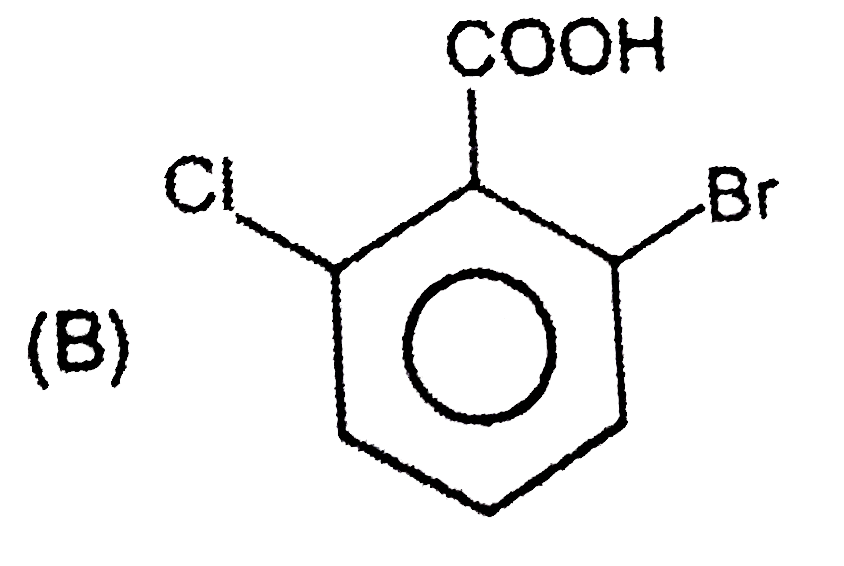(X) (C6H3CIBrCOOH) are a dihalosubstituted benzoic acids. The strongest acid among all isomers is -




The correct Answer is:B
To determine the strongest acid among the dihalosubstituted benzoic acids represented by the formula C6H3ClBrCOOH, we need to analyze the effects of the substituents (Cl and Br) on the acidity of the benzoic acid derivatives.
1. Identify the Isomers:
The given compound has the formula C6H3ClBrCOOH, which indicates that there are three positions on the benzene ring where the chlorine (Cl) and bromine (Br) can be substituted along with the carboxylic acid group (-COOH). The possible isomers can be:
- Ortho (1,2-substituted)
- Meta (1,3-substituted)
- Para (1,4-substituted)
2. Understand the Effect of Substituents:
Both Cl and Br are electron-withdrawing groups (EWG) due to their electronegativity. Their presence can enhance the acidity of the carboxylic acid group by stabilizing the negative charge on the conjugate base formed after deprotonation.
3. Consider the Ortho Effect:
The ortho effect refers to the increased acidity observed when electron-withdrawing groups are positioned ortho to the carboxylic acid group. This is due to two main reasons:
- It increases the partial positive charge on the acidic proton, making it easier to lose.
- It reduces the resonance stabilization of the conjugate base, making the conjugate base more stable.
4. Analyze Each Isomer:
- Isomer A (Ortho Cl and Meta Br): Strong acidity due to the ortho effect.
- Isomer B (Ortho Cl and Ortho Br): Strongest acidity due to both substituents being ortho, maximizing the ortho effect.
- Isomer C (Para Cl and Para Br): Weaker acidity as the substituents are in the para position, which does not benefit from the ortho effect.
- Isomer D (Meta Cl and Meta Br): Weakest acidity as both substituents are in the meta position, which does not enhance acidity.
5. Conclusion:
Among all the isomers, Isomer B (where both Cl and Br are in the ortho position) will be the strongest acid due to the combined effects of both electron-withdrawing groups enhancing the acidity through the ortho effect.
Final Answer:
The strongest acid among all isomers is Isomer B (both Cl and Br in ortho position).
---
The given compound has the formula C6H3ClBrCOOH, which indicates that there are three positions on the benzene ring where the chlorine (Cl) and bromine (Br) can be substituted along with the carboxylic acid group (-COOH). The possible isomers can be:
- Ortho (1,2-substituted)
- Meta (1,3-substituted)
- Para (1,4-substituted)
Both Cl and Br are electron-withdrawing groups (EWG) due to their electronegativity. Their presence can enhance the acidity of the carboxylic acid group by stabilizing the negative charge on the conjugate base formed after deprotonation.
The ortho effect refers to the increased acidity observed when electron-withdrawing groups are positioned ortho to the carboxylic acid group. This is due to two main reasons:
- It increases the partial positive charge on the acidic proton, making it easier to lose.
- It reduces the resonance stabilization of the conjugate base, making the conjugate base more stable.
- Isomer A (Ortho Cl and Meta Br): Strong acidity due to the ortho effect.
- Isomer B (Ortho Cl and Ortho Br): Strongest acidity due to both substituents being ortho, maximizing the ortho effect.
- Isomer C (Para Cl and Para Br): Weaker acidity as the substituents are in the para position, which does not benefit from the ortho effect.
- Isomer D (Meta Cl and Meta Br): Weakest acidity as both substituents are in the meta position, which does not enhance acidity.
Among all the isomers, Isomer B (where both Cl and Br are in the ortho position) will be the strongest acid due to the combined effects of both electron-withdrawing groups enhancing the acidity through the ortho effect.
The strongest acid among all isomers is Isomer B (both Cl and Br in ortho position).
Topper's Solved these Questions
- GENERAL ORGANIC CHEMISTRY IIBOOK - RESONANCE ENGLISHCHAPTER - GENERAL ORGANIC CHEMISTRY IIEXERCISE - Part-II: Single And Double Value Integer Type
9 Videos
- GENERAL ORGANIC CHEMISTRY IIBOOK - RESONANCE ENGLISHCHAPTER - GENERAL ORGANIC CHEMISTRY IIEXERCISE - Part-III: One or More Than One Options Correct Type
9 Videos
- GENERAL ORGANIC CHEMISTRY IIBOOK - RESONANCE ENGLISHCHAPTER - GENERAL ORGANIC CHEMISTRY IIEXERCISE - Part-III: Match the Column
2 Videos
- GASEOUS STATEBOOK - RESONANCE ENGLISHCHAPTER - GASEOUS STATEEXERCISE - ORGANIC CHEMISTRY(Hydrocarbon)
18 Videos
- GENERAL ORGANIC CHEMISTRY-IBOOK - RESONANCE ENGLISHCHAPTER - GENERAL ORGANIC CHEMISTRY-IEXERCISE - PART-III : PRACTICE TEST-19
1 Videos
Similar Questions
Knowledge Check

Which is the strongest acid in 1?AABBCCDD
Which is the strongest acid in 2 ?AABBCCDD
Which is the strongest acid in 4 ?AABBCCDD
